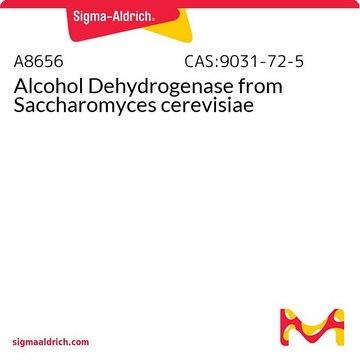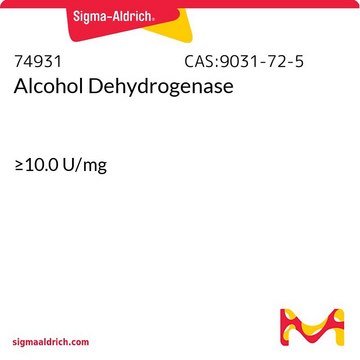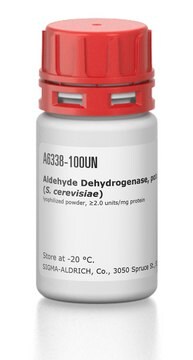A7011
Alcohol Dehydrogenase from Saccharomyces cerevisiae
≥300 units/mg protein, lyophilized powder (contains buffer salts), Mw 141-151 kDa
Synonyme(s) :
ADH1, Adh1p, SCAD, YDAH-1, YIM-1, ADH, Alcohol Dehydrogenase from yeast, Alcohol:NAD+ oxidoreductase
About This Item
Produits recommandés
Source biologique
Saccharomyces cerevisiae
Niveau de qualité
Forme
lyophilized powder (contains buffer salts)
Activité spécifique
≥300 units/mg protein
Poids mol.
Mw 141-151 kDa
Produit purifié par
crystallization
Conditions de stockage
(Keep container tightly closed in a dry and well-ventilated place.)
Caractéristiques du produit alternatif plus écologique
Waste Prevention
Design for Energy Efficiency
Learn more about the Principles of Green Chemistry.
sustainability
Greener Alternative Product
Couleur
white to light yellow-brown, Light brown
pH optimal
8.6-9.0
Solubilité
H2O: soluble 1.0 mg/mL, clear to slightly hazy, colorless to faintly yellow
soluble
Numéro d'accès UniProt
Application(s)
diagnostic assay manufacturing
Autre catégorie plus écologique
, Enabling
Conditions d'expédition
dry ice
Température de stockage
−20°C
Vous recherchez des produits similaires ? Visite Guide de comparaison des produits
Description générale
Yeast alcohol dehydrogenase 1 (ADH1) belongs to the family of zinc-containing alcohol dehydrogenases. It is a homotetramer with each subunit containing one catalytic domain and coenzyme-binding domain.
Application
Ethanol concentration can be determined colorimentrically by monitoring the enzymatic reduction of NAD using alcohol dehydrogenase after preremoval of the aldehyde group.
Actions biochimiques/physiologiques
Isoelectric point: 5.4-5.8
Optimal pH: 8.6-9.0
Substrates: Yeast ADH is most active with ethanol and its activity decreases as the size of the alcohol increases or decreases. Branched chain alcohols and secondary alcohols also have very low activity.
KM (ethanol) = 2.1 × 10-2 M
KM (methanol = 1.3 × 10-1 M
KM (isopropanol) = 1.4 × 10-1 M
Inhibitors: Compounds that react with free sulfhydryls, including N-alkylmaleimides and iodoacetamide.
Zinc chelator inhibitors, including 1,10-phenanthroline,
8-hydroxyquinoline, 2,2′-dipyridyl, and thiourea.
Substrate analogue inhibitors, including β-NAD analogs, purine and pyrimidine derivatives, chloroethanol, and fluoroethanol.
Extinction Coefficient: E1% = 14.6 (water, 280 nm)
Attention
Définition de l'unité
Forme physique
Notes préparatoires
Anticorps
Code de la classe de stockage
11 - Combustible Solids
Classe de danger pour l'eau (WGK)
WGK 3
Point d'éclair (°F)
Not applicable
Point d'éclair (°C)
Not applicable
Équipement de protection individuelle
Eyeshields, Gloves, type N95 (US)
Certificats d'analyse (COA)
Recherchez un Certificats d'analyse (COA) en saisissant le numéro de lot du produit. Les numéros de lot figurent sur l'étiquette du produit après les mots "Lot" ou "Batch".
Déjà en possession de ce produit ?
Retrouvez la documentation relative aux produits que vous avez récemment achetés dans la Bibliothèque de documents.
Les clients ont également consulté
Protocoles
This procedure may be used for Alcohol Dehydrogenase products.
Notre équipe de scientifiques dispose d'une expérience dans tous les secteurs de la recherche, notamment en sciences de la vie, science des matériaux, synthèse chimique, chromatographie, analyse et dans de nombreux autres domaines..
Contacter notre Service technique








